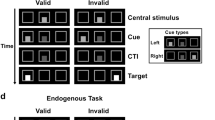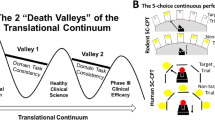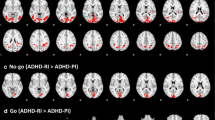Abstract
Rationale
Atypical attention orienting has been associated with some autistic symptoms, but the neural mechanisms remain unclear. The human Posner task, a classic attention orienting paradigm, was recently adapted for use with mice, supporting the investigation of the neurobiological underpinnings of atypical attention orienting in preclinical mouse models.
Objective
The current study tested mice expressing the autism-associated R451C gene mutation in neuroligin-3 (NL3) on the mouse-Posner (mPosner) task.
Methods
NL3R451C and wild-type (WT) mice were trained to respond to a validly or invalidly cued target on a touchscreen. The cue was a peripheral non-predictive flash in the exogenous task and a central spatially predictive image in the endogenous task. The effects of dopaminergic- and noradrenergic-modulating drugs, methylphenidate and atomoxetine, on task performance were assessed.
Results
In both tasks, mice were quicker and more accurate in the validly versus invalidly cued trials, consistent with results in the human Posner task. NL3R451C and WT mice showed similar response times and accuracy but responded differently when treated with methylphenidate and atomoxetine. Methylphenidate impaired exogenous attention disengagement in NL3R451C mice but did not significantly affect WT mice. Atomoxetine impaired endogenous orienting in WT mice but did not significantly affect NL3R451C mice.
Conclusions
NL3R451C mice demonstrated intact attention orienting but altered responses to the pharmacological manipulation of the dopaminergic and noradrenergic networks. These findings expand our understanding of the NL3R451C mutation by suggesting that this mutation may lead to selective alterations in attentional processes.





Similar content being viewed by others
Data Availability
The data that support the findings of this study are available from the corresponding authors upon reasonable request.
References
Baker EK, Richdale AL, Hazi A, Prendergast LA (2019) Assessing a hyperarousal hypothesis of insomnia in adults with autism spectrum disorder. Autism Res 12:897–910. https://doi.org/10.1002/aur.2094
Baranek GT, Woynaroski TG, Nowell S, Turner-Brown L, DuBay M, Crais ER, Watson LR (2018) Cascading effects of attention disengagement and sensory seeking on social symptoms in a community sample of infants at-risk for a future diagnosis of autism spectrum disorder. Dev Cogn Neurosci 29:30–40. https://doi.org/10.1016/j.dcn.2017.08.006
Bariselli S, Hörnberg H, Prévost-Solié C, Musardo S, Hatstatt-Burklé L, Scheiffele P, Bellone C (2018) Role of VTA dopamine neurons and neuroligin 3 in sociability traits related to nonfamiliar conspecific interaction. Nat Commun 9:3173. https://doi.org/10.1038/s41467-018-05382-3
Bast N, Boxhoorn S, Supér H, Helfer B, Polzer L, Klein C, Cholemkery H, Freitag CM (2023) Atypical Arousal Regulation in Children With Autism but Not With Attention-Deficit/Hyperactivity Disorder as Indicated by Pupillometric Measures of Locus Coeruleus Activity. Biol Psychiatry Cogn Neurosci Neuroimaging 8:11–20. https://doi.org/10.1016/j.bpsc.2021.04.010
Bellgrove MA, Barry E, Johnson KA, Cox M, Dáibhis A, Daly M, Hawi Z, Lambert D, Fitzgerald M, McNicholas F, Robertson IH, Gill M, Kirley A (2008) Spatial attentional bias as a marker of genetic risk, symptom severity, and stimulant response in ADHD. Neuropsychopharmacology 33:2536–2545. https://doi.org/10.1038/sj.npp.1301637
Berridge CW, Devilbiss DM, Andrzejewski ME, Arnsten AFT, Kelley AE, Schmeichel B, Hamilton C, Spencer RC (2006) Methylphenidate preferentially increases catecholamine neurotransmission within the prefrontal cortex at low doses that enhance cognitive function. Biol Psychiatry 60:1111–1120. https://doi.org/10.1016/j.biopsych.2006.04.022
Braet W, Johnson KA, Tobin CT, Acheson R, McDonnell C, Hawi Z, Barry E, Mulligan A, Gill M, Bellgrove MA, Robertson IH, Garavan H (2011) FMRI activation during response inhibition and error processing: The role of the DAT1 gene in typically developing adolescents and those diagnosed with ADHD. Neuropsychologia 49:1641–1650. https://doi.org/10.1016/j.neuropsychologia.2011.01.001
Burrows EL, Laskaris L, Koyama L, Churilov L, Bornstein JC, Hill-Yardin EL, Hannan AJ (2015) A neuroligin-3 mutation implicated in autism causes abnormal aggression and increases repetitive behavior in mice. Mol Autism 6:1–11. https://doi.org/10.1186/s13229-015-0055-7
Burrows EL, Eastwood AF, May C, Kolbe SC, Hill T, McLachlan NM, Churilov L, Hannan AJ (2017) Social Isolation alters social and mating behavior in the R451C neuroligin mouse model of autism. Neural Plast 2017:1–9. https://doi.org/10.1155/2017/8361290
Burrows EL, May C, Hill T, Churliov L, Johnson KA, Hannan AJ (2022) Mice with an autism-associated R451C mutation in neuroligin-3 show a cautious but accurate response style in touchscreen attention tasks. Genes, Brain Behav 21:1–14. https://doi.org/10.1111/gbb.12757
Bymaster FP, Katner JS, Nelson DL, Hemrick-Luecke SK, Threlkeld PG, Heiligenstein JH, Morin SM, Gehlert DR, Perry KW (2002) Atomoxetine increases extracellular levels of norepinephrine and dopamine in prefrontal cortex of rat: a potential mechanism for efficacy in attention deficit/hyperactivity disorder. Neuropsychopharmacology 27:699–711. https://doi.org/10.1016/S0893-133X(02)00346-9
Caballero-Puntiverio M, Fitzpatrick CM, Woldbye DPD, Andreasen JT (2017) Effects of amphetamine and methylphenidate on attentional performance and impulsivity in the mouse 5-choice serial reaction time task. J Psychopharmacol 31:272–283. https://doi.org/10.1177/0269881116684339
Caballero-Puntiverio M, Lerdrup LS, Grupe M, Larsen CW, Dietz AG, Andreasen JT (2019) Effect of ADHD medication in male C57BL/6J mice performing the rodent Continuous Performance Test. Psychopharmacology 236:1839–1851. https://doi.org/10.1007/s00213-019-5167-x
Caballero-Puntiverio M, Lerdrup LS, Arvastson L, Aznar S, Andreasen JT (2020) ADHD medication and the inverted U-shaped curve: a pharmacological study in female mice performing the rodent Continuous Performance Test (rCPT). Prog Neuro-Psychopharmacology Biol Psychiatry 99:109823. https://doi.org/10.1016/j.pnpbp.2019.109823
Canu D, Van der Paelt S, Canal-Bedia R, Posada M, Vanvuchelen M, Roeyers H (2021) Early non-social behavioural indicators of autism spectrum disorder (ASD) in siblings at elevated likelihood for ASD: a systematic review. Eur Child Adolesc Psychiatry 30:497–538. https://doi.org/10.1007/s00787-020-01487-7
Cao W, Lin S, Xia Q qiang, Du Y lan, Yang Q, Zhang M ying, Lu Y qing, Xu J, Duan S min, Xia J, Feng G, Xu J, Luo JH (2018) Gamma oscillation dysfunction in mPFC leads to social deficits in neuroligin 3 R451C knockin mice. Neuron 97:1253-1260.e7. https://doi.org/10.1016/j.neuron.2018.02.001
Casteau S, Smith DT (2020) Covert attention beyond the range of eye-movements: evidence for a dissociation between exogenous and endogenous orienting. Cortex 122:170–186. https://doi.org/10.1016/j.cortex.2018.11.007
Clinton SM, Unroe KA, Shupe EA, McCoy CR, Glover ME (2022) Resilience to stress: lessons from rodents about nature versus nurture. Neuroscientist 28:283–298. https://doi.org/10.1177/1073858421989357
Comoletti D (2004) The Arg451Cys-Neuroligin-3 mutation associated with autism reveals a defect in protein processing. J Neurosci 24:4889–4893. https://doi.org/10.1523/JNEUROSCI.0468-04.2004
Ellegood J, Lerch JP, Henkelman RM (2011) Brain abnormalities in a Neuroligin3 R451C knockin mouse model associated with autism. Autism Res 4:368–376. https://doi.org/10.1002/aur.215
Ellegood J, Anagnostou E, Babineau BA, Crawley JN, Lin L, Genestine M, DiCicco-Bloom E, Lai JKY, Foster JA, Peñagarikano O, Geschwind DH, Pacey LK, Hampson DR, Laliberté CL, Mills AA, Tam E, Osborne LR, Kouser M, Espinosa-Becerra F et al (2015) Clustering autism: using neuroanatomical differences in 26 mouse models to gain insight into the heterogeneity. Mol Psychiatry 20:118–125. https://doi.org/10.1038/mp.2014.98
Elsabbagh M, Fernandes J, Jane Webb S, Dawson G, Charman T, Johnson MH (2013) Disengagement of visual attention in infancy is associated with emerging autism in toddlerhood. Biol Psychiatry 74:189–194. https://doi.org/10.1016/j.biopsych.2012.11.030
Etherton M, Foldy C, Sharma M, Tabuchi K, Liu X, Shamloo M, Malenka RC, Sudhof TC (2011) Autism-linked neuroligin-3 R451C mutation differentially alters hippocampal and cortical synaptic function. Proc Natl Acad Sci 108:13764–13769. https://doi.org/10.1073/pnas.1111093108
Fitzpatrick CM, Caballero-Puntiverio M, Gether U, Habekost T, Bundesen C, Vangkilde S, Woldbye DPD, Andreasen JT, Petersen A (2017) Theory of Visual Attention (TVA) applied to mice in the 5-choice serial reaction time task. Psychopharmacology 234:845–855. https://doi.org/10.1007/s00213-016-4520-6
Fossella J, Sommer T, Fan J, Wu Y, Swanson JM, Pfaff DW, Posner MI (2002) Assessing the molecular genetics of attention networks. BMC Neurosci 3:1–11. https://doi.org/10.1186/1471-2202-3-14
Graf H, Abler B, Freudenmann R, Beschoner P, Schaeffeler E, Spitzer M, Schwab M, Grön G (2011) Neural correlates of error monitoring modulated by atomoxetine in healthy volunteers. Biol Psychiatry 69:890–897. https://doi.org/10.1016/j.biopsych.2010.10.018
Grove J, Ripke S, Als TD, Mattheisen M, Walters RK, Won H, Pallesen J, Agerbo E, Andreassen OA, Anney R, Awashti S, Belliveau R, Bettella F, Buxbaum JD, Bybjerg-Grauholm J, Bækvad-Hansen M, Cerrato F, Chambert K, Christensen JH et al (2019) Identification of common genetic risk variants for autism spectrum disorder. Nat Genet 51:431–444. https://doi.org/10.1038/s41588-019-0344-8
Hosie S, Malone DT, Liu S, Glass M, Adlard PA, Hannan AJ, Hill-Yardin EL (2018) Altered amygdala excitation and CB1 receptor modulation of aggressive behavior in the neuroligin-3R451C mouse model of autism. Front Cell Neurosci 12:1–10. https://doi.org/10.3389/fncel.2018.00234
Jamain S, Quach H, Betancur C, Råstam M, Colineaux C, Gillberg IC, Soderstrom H, Giros B, Leboyer M, Gillberg C, Bourgeron T (2003) Mutations of the X-linked genes encoding neuroligins NLGN3 and NLGN4 are associated with autism. Nat Genet 34:27–29. https://doi.org/10.1038/ng1136
Jaramillo TC, Liu S, Pettersen A, Birnbaum SG, Powell CM (2014) Autism-related neuroligin-3 mutation alters social behavior and spatial learning. Autism Res 7:264–272. https://doi.org/10.1002/aur.1362
Jentsch JD, Aarde SM, Seu E (2009) Effects of atomoxetine and methylphenidate on performance of a lateralized reaction time task in rats. Psychopharmacology 202:497–504. https://doi.org/10.1007/s00213-008-1181-0
Jobski K, Höfer J, Hoffmann F, Bachmann C (2017) Use of psychotropic drugs in patients with autism spectrum disorders: a systematic review. Acta Psychiatr Scand 135:8–28. https://doi.org/10.1111/acps.12644
Johnson KA, Barry E, Bellgrove MA, Cox M, Kelly SP, Dáibhis A, Daly M, Keavey M, Watchorn A, Fitzgerald M, McNicholas F, Kirley A, Robertson IH, Gill M (2008) Dissociation in response to methylphenidate on response variability in a group of medication naïve children with ADHD. Neuropsychologia 46:1532–1541. https://doi.org/10.1016/j.neuropsychologia.2008.01.002
Johnson KA, Barry E, Lambert D, Fitzgerald M, McNicholas F, Kirley A, Gill M, Bellgrove MA, Hawi Z (2013) Methylphenidate side effect profile is influenced by genetic variation in the attention-deficit/hyperactivity disorder-associated CES1 gene. J Child Adolesc Psychopharmacol 23:655–664. https://doi.org/10.1089/cap.2013.0032
Koda K, Ago Y, Cong Y, Kita Y, Takuma K, Matsuda T (2010) Effects of acute and chronic administration of atomoxetine and methylphenidate on extracellular levels of noradrenaline, dopamine and serotonin in the prefrontal cortex and striatum of mice. J Neurochem 114:259–270. https://doi.org/10.1111/j.1471-4159.2010.06750.x
Kodama T, Kojima T, Honda Y, Hosokawa T, Tsutsui KI, Watanabe M (2017) Oral administration of methylphenidate (Ritalin) affects dopamine release differentially between the prefrontal cortex and striatum: a microdialysis study in the monkey. J Neurosci 37:2387–2394. https://doi.org/10.1523/JNEUROSCI.2155-16.2017
Kowalczyk OS, Cubillo AI, Smith A, Barrett N, Giampietro V, Brammer M, Simmons A, Rubia K (2019) Methylphenidate and atomoxetine normalise fronto-parietal underactivation during sustained attention in ADHD adolescents. Eur Neuropsychopharmacol 29:1102–1116. https://doi.org/10.1016/j.euroneuro.2019.07.139
Kratz O, Studer P, Baack J, Malcherek S, Erbe K, Moll GH, Heinrich H (2012) Differential effects of methylphenidate and atomoxetine on attentional processes in children with ADHD: an event-related potential study using the Attention Network Test. Prog Neuro-Psychopharmacology Biol Psychiatry 37:81–89. https://doi.org/10.1016/j.pnpbp.2011.12.008
Kumar M, Duda JT, Hwang WT, Kenworthy C, Ittyerah R, Pickup S, Brodkin ES, Gee JC, Abel T, Poptani H (2014) High resolution magnetic resonance imaging for characterization of the Neuroligin-3 knock-in mouse model associated with autism spectrum disorder. PLoS One 9. https://doi.org/10.1371/journal.pone.0109872
Kylliäinen A, Wallace S, Coutanche MN, Leppänen JM, Cusack J, Bailey AJ, Hietanen JK (2012) Affective-motivational brain responses to direct gaze in children with autism spectrum disorder. J Child Psychol Psychiatry Allied Discip 53:790–797. https://doi.org/10.1111/j.1469-7610.2011.02522.x
Landry O, Parker A (2013) A meta-analysis of visual orienting in autism. Front Hum Neurosci 7:833. https://doi.org/10.3389/fnhum.2013.00833
Li S, May C, Hannan AJ, Johnson KA, Burrows EL (2021) Assessing attention orienting in mice: a novel touchscreen adaptation of the Posner-style cueing task. Neuropsychopharmacology 46:432–441. https://doi.org/10.1038/s41386-020-00873-8
Mar AC, Horner AE, Nilsson SRO, Alsiö J, Kent BA, Kim CH, Holmes A, Saksida LM, Bussey TJ (2013) The touchscreen operant platform for assessing executive function in rats and mice. Nat Protoc 8:1985–2005. https://doi.org/10.1038/nprot.2013.123
Martella G, Meringolo M, Trobiani L, De Jaco A, Pisani A, Bonsi P, De JA, Pisani A, Bonsi P (2018) The neurobiological bases of autism spectrum disorders: the R451C-neuroligin 3 mutation hampers the expression of long-term synaptic depression in the dorsal striatum. Eur J Neurosci 47:701–708. https://doi.org/10.1111/ejn.13705
Matoba N, Liang D, Sun H, Aygün N, McAfee JC, Davis JE, Raffield LM, Qian H, Piven J, Li Y, Kosuri S, Won H, Stein JL (2020) Common genetic risk variants identified in the SPARK cohort support DDHD2 as a candidate risk gene for autism. Transl Psychiatry 10. https://doi.org/10.1038/s41398-020-00953-9
Matta SM, Moore Z, Walker FR, Hill-Yardin EL, Crack PJ (2020) An altered glial phenotype in the NL3R451C mouse model of autism. Sci Rep 10:1–13. https://doi.org/10.1038/s41598-020-71171-y
Meyer AF, O’Keefe J, Poort J (2020) Two Distinct Types of Eye-Head Coupling in Freely Moving Mice. Curr Biol 30:2116–2130. https://doi.org/10.1016/j.cub.2020.04.042
Mizuno Y, Cai W, Supekar K, Makita K, Takiguchi S, Tomoda A, Menon V (2022) Methylphenidate remediates aberrant brain network dynamics in children with attention-deficit/hyperactivity disorder: a randomized controlled trial. Neuroimage 257:119332. https://doi.org/10.1016/j.neuroimage.2022.119332
Norris RHCC, Churilov L, Hannan AJ, Nithianantharajah J (2019) Mutations in neuroligin-3 in male mice impact behavioral flexibility but not relational memory in a touchscreen test of visual transitive inference. Mol Autism 10:1–21. https://doi.org/10.1186/s13229-019-0292-2
Paton K, Hammond P, Barry E, Fitzgerald M, McNicholas F, Kirley A, Robertson IH, Bellgrove MA, Gill M, Johnson KA (2014) Methylphenidate improves some but not all measures of ATTENTION, as measured by the TEA-Ch in medication-naïve children with ADHD. Child Neuropsychol 20:303–318. https://doi.org/10.1080/09297049.2013.790358
Pearson DA, Santos CW, Aman MG, Arnold LE, Lane DM, Loveland KA, Mansour R, Ward AR, Casat CD, Jerger S, Schachar RJ, Bukstein OG, Cleveland LA (2020) Effects of extended-release methylphenidate treatment on cognitive task performance in children with autism spectrum disorder and attention-deficit/hyperactivity disorder. J Child Adolesc Psychopharmacol 30:414–426. https://doi.org/10.1089/cap.2020.0004
Posner MI (1980) Orienting of attention. Q J Exp Psychol 32:3–25. https://doi.org/10.1080/00335558008248231
Rasmussen L, Pratt N, Roughead E, Moffat A (2019) Prevalence of psychotropic medicine use in Australian children with autism spectrum disorder: a drug utilization study based on children enrolled in the longitudinal study of Australian children. J Autism Dev Disord 49:227–235. https://doi.org/10.1007/s10803-018-3718-3
Rothwell PE, Fuccillo MV, Maxeiner S, Hayton SJ, Gokce O, Lim BK, Fowler SC, Malenka RC, Südhof TC (2014) Autism-associated neuroligin-3 mutations commonly impair striatal circuits to boost repetitive behaviors. Cell 158:198–212. https://doi.org/10.1016/j.cell.2014.04.045
Satterstrom FK, Kosmicki JA, Wang J, Breen MS, De Rubeis S, An JY, Peng M, Collins R, Grove J, Klei L, Stevens C, Reichert J, Mulhern MS, Artomov M, Gerges S, Sheppard B, Xu X, Bhaduri A, Norman U et al (2020) Large-scale exome sequencing study implicates both developmental and functional changes in the neurobiology of autism. Cell 180:568-584.e23. https://doi.org/10.1016/j.cell.2019.12.036
Südhof TC (2008) Neuroligins and neurexins link synaptic function to cognitive disease. Nature 455:903–911. https://doi.org/10.1038/nature07456
Tabuchi K, Blundell J, Etherton MR, Hammer RE, Liu X, Powell CM, Südhof TC (2007) A Neuroligin-3 Mutation Implicated in Autism Increases Inhibitory Synaptic Transmission in Mice. Science (80-) 318:71–76. https://doi.org/10.1126/science.1146221
Trevisan DA, Roberts N, Lin C, Birmingham E (2017) How do adults and teens with self-declared Autism Spectrum Disorder experience eye contact? A qualitative analysis of first-hand accounts. PLoS ONE 12:e0188446. https://doi.org/10.1371/journal.pone.0188446
Tucha O, Mecklinger L, Laufkötter R, Klein HE, Walitza S, Lange KW (2006) Methylphenidate-induced improvements of various measures of attention in adults with attention deficit hyperactivity disorder. J Neural Transm 113:1575–1592. https://doi.org/10.1007/s00702-005-0437-7
Zeleznikow-Johnston A, Burrows EL, Renoir T, Hannan AJ (2017) Environmental enrichment enhances cognitive flexibility in C57BL/6 mice on a touchscreen reversal learning task. Neuropharmacology 117:219–226. https://doi.org/10.1016/j.neuropharm.2017.02.009
Acknowledgements
We thank Maddison Ible, Daniel Drieberg, and Brett Purcell for mouse husbandry and management of equipment. We are also grateful to our laboratory members for helpful discussions and technical support.
Funding
SL is supported by the Melbourne Research Scholarship established by the University of Melbourne. ELB is supported by a National Health and Medical Research Council-Australian Research Council (NHMRC-ARC) Dementia Research Development Fellowship (1111552) and funding from TDM Growth Partners and Hearts and Minds Investments. AJH is a National Health and Medical Research Council (NHMRC) Principal Research Fellow and has been supported by an Australian Research Council (ARC) FT3 Future Fellowship (FT100100835).
Author information
Authors and Affiliations
Contributions
SL, KAJ, and ELB conceived and designed the study. SL and ELB carried out the experiments with assistance from TYP. SL analysed the data with statistical advice from CM, LC, and ELB. SL, KAJ, and ELB contributed to the interpretation of the results. SL wrote the manuscript with input from KAJ, ELB, LC, TYP, and AJH. All authors read the final version and consented to publishing this manuscript.
Corresponding authors
Ethics declarations
Conflict of interest
The authors declare that they have no conflicts of interest.
Additional information
Publisher's Note
Springer Nature remains neutral with regard to jurisdictional claims in published maps and institutional affiliations.
Katherine A. Johnson and Emma L. Burrows are joint senior authors.
Supplementary Information
Below is the link to the electronic supplementary material.
Rights and permissions
Springer Nature or its licensor (e.g. a society or other partner) holds exclusive rights to this article under a publishing agreement with the author(s) or other rightsholder(s); author self-archiving of the accepted manuscript version of this article is solely governed by the terms of such publishing agreement and applicable law.
About this article
Cite this article
Li, S., May, C., Pang, T.Y. et al. Mice with an autism-associated R451C mutation in neuroligin-3 show intact attention orienting but atypical responses to methylphenidate and atomoxetine in the mouse-Posner task. Psychopharmacology 241, 555–567 (2024). https://doi.org/10.1007/s00213-023-06520-6
Received:
Accepted:
Published:
Issue Date:
DOI: https://doi.org/10.1007/s00213-023-06520-6




